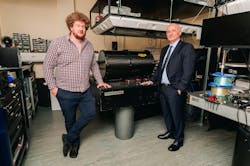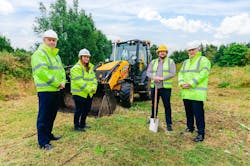Optical ground stations push boundaries of space technology
In the rapidly evolving landscape of space technology, optical ground stations are becoming increasingly crucial. These facilities provide a vital link between Earth and satellites to enable high-speed communications, advanced research, and innovative applications.
We're taking a significant step forward with the construction of our own £2.5 million ($3.27M) optical ground station, set to become operational by the end of this year. The facility, known as the Hub Optical Ground Station (a.k.a. HOGS) and based at Heriot-Watt University, is poised to push the boundaries of space technology and contribute to the U.K.'s position as a global leader in quantum technology research (see video).
The rise of optical ground stations
Optical ground stations gained prominence in recent years due to their ability to support high-bandwidth optical communications with satellites using laser technology. Unlike traditional radio frequency communications, optical links offer higher data rates, improved security, and reduced power consumption. These advantages make optical ground stations essential for advancing satellite communications, Earth observation, and space-based research.
Several notable optical ground stations are already in operation around the world, such as the European Space Agency's facility in Tenerife, Spain, which has been operational since 1995 and played a crucial role in various space missions and experiments. NASA's Optical Communications Telescope Laboratory at Table Mountain Observatory in California supports the agency's deep-space optical communications projects. While these facilities have made outstanding contributions to the field, HOGS will add unique capabilities and research focus areas.
Demonstration capabilities in Scotland
Scotland is experiencing a rapidly growing space industry, attracting international as well as inward investment, expertise, and employment opportunities. Universities like our own have a pivotal role to play in this journey. There is an inherent connection between academia, industry, and innovation, and at Heriot-Watt University we are developing a space tech cluster at our research park.
Universities are not just centers of education; they are hubs of creativity, research, and development to address some of the biggest challenges facing society. Our new facility represents a comprehensive approach to space technology research—combining cutting-edge hardware with innovative research programs.
At the heart of HOGS is its role in advancing quantum communications technology. As part of the Quantum Communications Hub's in-orbit demonstrator mission (Satellite Platform for Optical Quantum Communications; SPOQC), HOGS will be instrumental in showcasing the U.K.'s academic capabilities in satellite quantum secure communications.
The facility will feature state-of-the-art equipment for quantum key distribution experiments, including single-photon detectors and adaptive optics systems. This will enable us to develop and test new protocols for secure satellite-to-ground quantum communications, a critical area for future cybersecurity applications.
Versatile infrastructure
HOGS boasts a comprehensive set of infrastructure that makes it highly adaptable for various research purposes, including a 4.5-m-diameter clamshell-style observatory dome, a 70-cm-diameter optical terminal with a Nasmyth observatory telescope, two 100-kg ground payload capabilities, and a 40-cm-piggyback telescope with visible and infrared cameras for coarse tracking and space imaging.
Environmental monitoring tools will measure local conditions, including atmospheric turbulence. This versatile setup allows us to support a wide range of missions and observations, from quantum communications experiments to space debris tracking and astronomical observations.
Integration with campus network
Unlike many standalone optical ground stations, HOGS will be directly connected to a campus-based dark optical-fiber network. This integration links the facility with local academic buildings and a lab-based network simulator to provide access to next-generation quantum and photonic systems essential for quantum networking research.
The network simulator offers point-to-point links ranging from 10 to 300 km, which allows us to test and develop technologies for future quantum networks in a controlled environment before deploying them in real-world scenarios.
Multi-mission capability
While quantum communication is its primary focus, HOGS supports a variety of space-related research areas like optical communications. We will be exploring high-bandwidth capabilities for future satellite communications systems, as well as testing space situational awareness, leveraging our northern location for excellent visibility of satellites and debris within low-Earth polar orbit.
Finally, we will be exploring astrophotonics by testing new photonic devices for improved astronomical measurements. This multi-mission approach ensures that HOGS will remain at the forefront of space technology research for years to come.
Advancing the U.K.'s space capabilities
The development of HOGS aligns with broader initiatives to strengthen the U.K.'s position within the global space sector. It complements other investments in quantum technology research and development, such as the recently announced Integrated Quantum Networks (IQN) Hub, which aims to develop technologies for an ultrasecure quantum internet of the future.
By providing a world-class facility for researchers and industry partners, HOGS will play a crucial role in fostering collaboration between academia and industry as well as training the next generation of space technology experts.
Other U.K. researchers with relevant interests in experimental satellite quantum communications will be invited to work onsite using the modern telescope to track satellite paths with high precision. Heriot-Watt students, from undergraduate to Ph.D., will benefit from the new capabilities, and local school children can be hosted onsite to build their knowledge and understanding of satellite communications and astronomy.
Challenges and opportunities
As we embark on this exciting journey, we're mindful of the challenges that lie ahead. Developing and operating a cutting-edge optical ground station requires overcoming technical hurdles, navigating regulatory landscapes, and addressing potential environmental concerns.
But these challenges also present opportunities for innovation. For instance, developing new adaptive optics techniques to mitigate atmospheric turbulence effects on laser communications, creating more efficient and sensitive single-photon detectors for quantum communications, and designing novel algorithms for space debris tracking and identification.
By tackling these challenges head-on, we aim to push the boundaries of what's possible in space technology and contribute to solutions that benefit not just the U.K., but the global scientific community.
Looking to the future
As we approach the completion of HOGS in 2024, we're already looking ahead to its potential impact and future developments. These include connecting HOGS to a Scottish Quantum Network, linking universities and business centers across Scotland's Central Belt, integrating with the U.K. Quantum Network and other global networks to facilitate international collaborations, and exploring new applications in fields such as Earth observation, climate monitoring, and deep-space communications.
We believe HOGS will serve as a catalyst for innovation within the U.K. space sector to drive advancements in quantum technologies, optical communications, and space situational awareness.
As we move forward, we invite researchers, industry partners, and space enthusiasts to join us on this exciting journey. Together, we can push the boundaries of what's possible in space technology and contribute to a more connected, secure, and technologically advanced future.
About the Author
Ross Donaldson
Dr. Ross Donaldson leads the Hub Optical Ground Station project at Heriot-Watt University. With expertise in quantum communications and photonics, he is dedicated to advancing space technology research and fostering collaboration between academia and industry. The facility is being built as part of the Quantum Communications Hub project, funded through the U.K. National Quantum Technologies Programme and is part of a collaborative effort which also involves the Universities of Bristol, Strathclyde, and York. Space engineering expertise is provided by the Science and Technology Facilities Council’s RAL Space Facility.

